Green Closet
Reduce, Rewear, Recycle
Team




Problem and Design Overview
The evergrowing clothes industry has detrimental effects on our planet both in creating clothing and disposing unworn items. It has more greenhouse gas emissions than all international flights and maritime shipping combined. Additionally, every year, the average American throws away 81.5 lbs of clothes. Globally, 92 million tonnes of clothing waste end up in landfills per year. It takes a toll on the environment to favor the acquistion of new items while neglecting what we already own.
That's where Green Closet comes in. Green Closet allows participants to keep track of what they are wearing and how often they are wearing it. In turn, participants can identify their most and least used items in their closet and either change their outfits or give away what they no longer need. In doing so, Green Closet helps people to ensure they do not own or acquire clothes they won't wear and encourage recyling and thrifting over buying new items.

Green Closet helps people maximize clothes they already own by keeping track of how much of their closet they are using
Design Research Process and Key Insights
When designing our solution, we wanted chose to focus on three main things for our research phase: problems, reasons, and possible solution motivations. That is, identifying issues and their reasons and possible ways we could motivate people to fix these issues.
People have different reasons and motivations behind their actions and that includes those pertaining to their closet. For example, a shirt may be unworn because it's forgotten or because it's hard to outfit plan around. Similarly, how we then attempt to solve the issue needs to match the motivation of our targeted user group (fashion, environment, money, etc.) or else we risk creating a solution nobody wants.
For our design research, we chose to do a survey followed by interviews because the survey allowed us to poll a large number of people with minimal effort and narrow down our problem space. In our survey, we asked them multiple choice questions like how much of their closet they used and how much they valued sustainability on a scale of 1 to 5. From there, we were able to decide what questions and areas to investiage more during our interviews. For example, we explored the exact reasons behind why people tended to neglect certain items and their daily routine when choosing an outfit for the day.
We chose to focus on UW students since they are easily accessible. Additionally, young adults are more likely to engage in fast fashion, thrifting, and exchanging clothes via an app so they would be able to take advantage or be in need of our app's services.
Most people do not use their entire closets
As we buy and receive clothes, they easily pile up in our closets never to be seen again. During our research, we wanted to find out how widespread and severe this problem was with our participants. From our survey, 87.5% of participants estimated that they use 80% or less of their closet on a day-to-day basis. In our interviews, all participants estimated at or below 70% use. These results show us that the problem is very common and significantly severe enough to address.
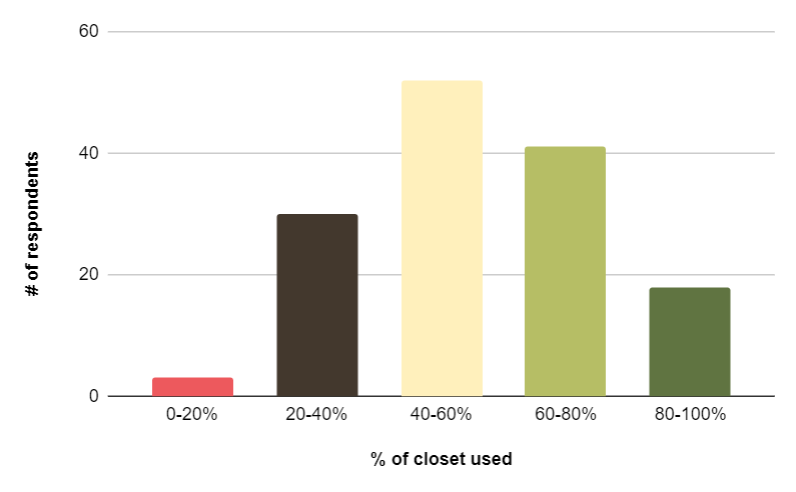
How much of their closets do people report wearing?
People neglect certain clothing items for different reasons
In our survey, outside of niche and seasonal clothing, people most often cited forgetting the item exists (45.1%) and having difficulty outfit planning with it (44.4%). Less common but still significant, 15.3% said they couldn't find the article of clothing and 16% claimed they had too many clothes and simply couldn't wear them all.

Many people cannot implement sustainability to the extent they would like
In a world in which it's increasingly becoming more important to be sustainable, it has also become significantly hard to actually act upon goals of helping the planet. One participant said they perceive sustainability in fashion as "important" but "sometimes their actions don't align with their values." That is, they may shop at stores like Target and H&M out of accessibility and convenience. Those who do not value sustainability in their daily lives describe the difficulty in incorporating those practices as the primary reason why they have abandoned this value.

Clothing stores in UVillage (none of which are thrift stores)
Iterative Design Process and Key Insights
We focused our design on two tasks: optimizing how a participant utilizes their closet and facilitating the exchange of secondhand clothes. Our iterative design process began by creating an initial paper prototype of our application. Then we ran two heuristic evaluations on it, identifying and resolving violations. Next, we conducted three usability tests. Our participants were college students with varying degrees of familiarity with self-tracking applications. Two of our participants had experience thrifting and valued sustainability in fashion. We began each test by giving a summary of our project and our design and explaining our two tasks. Then we had users attempt to complete both tasks with the prototype. From these usability tests, we identified multiple issues with our design and workflows, which are discussed below.

Overview of Paper Prototype
Added Workflow to Exchange a Specific Piece of Clothing
This insight emerged during our first usability test when the participant clicked the “exchange” button on a specific item and we had no screen to show other than the “give” view of the exchange page. To address this, we added a “pre-post” window where the participant can add additional information about an item before posting it on the app, such as a title, description, price, tags, and images.

New pre-post page for exchange workflow
Further Integrated User Statistics
This insight also emerged during our first usability test after the participant had completed both design tasks. They had previous experience with self-tracking apps and wished that statistics related to themselves and their closet use were easier to locate. To address this, we integrated user statistics more throughout the application. On the profile page we added a graph that displays the user's closest usage over time in addition to a button that navigates to the “stats” view of the closet page. When a user selects an item in their closet, there is now a button on that page that takes them to a detailed view of that item's statistics. There is also a button that navigates to an item's statistics when the user selects a piece on the home page.



The profile, closet, and item views are now better integrated with statistics
Modified Button Descriptions to Add Clarity
This insight emerged during our third usability test when the participant was unclear on how to confirm the wear of an outfit for the day. They thought that, by adding a piece of clothing to the daily outfit, they were confirming the wear of that piece. To address this we changed the description of the check mark under a specific item of clothing to “Add to outfit” instead of “Wear it!”, and the description of the check mark on the home page to “Wear it!”. That way, it’s clear that the check mark buttons do different things.

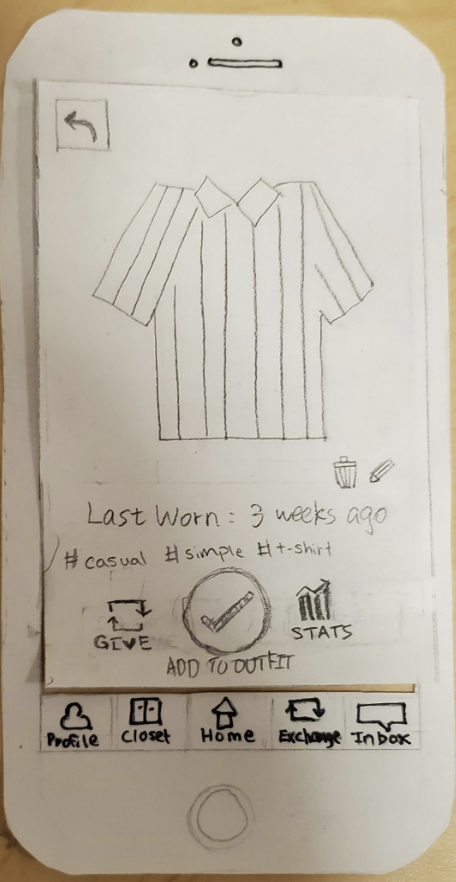
The home page's check button says "Wear It!" while the item's says "Add to Outfit"
Resulting Design
Our resulting design for Green Closet consists of the scanner and an application. The scanner makes outfit tracking intuitive alongside the physical act of taking items out of your closet and simplifies the process of uploading images for second-hand exchange. With the application, sustainable outfit planning is accomplished by the algorithm suggesting outfits according to personal style and usage statistics, encouraging participants to use their closets to the fullest. The participant can also use their statistics to identify their least-worn clothes and upload them to our second-hand exchange platform.
Task 1: Identifying Personal Style and How You Use Your Clothes
The homepage recommends an outfit based on personal style self-tracking data, weather, and activities. Clicking the shuffle button generates a new recommended outfit. Clicking on an item in the outfit provides quick stats and options to browse the closet to replace that item, view detailed statistics for that item, or shuffle only that item in the outfit.
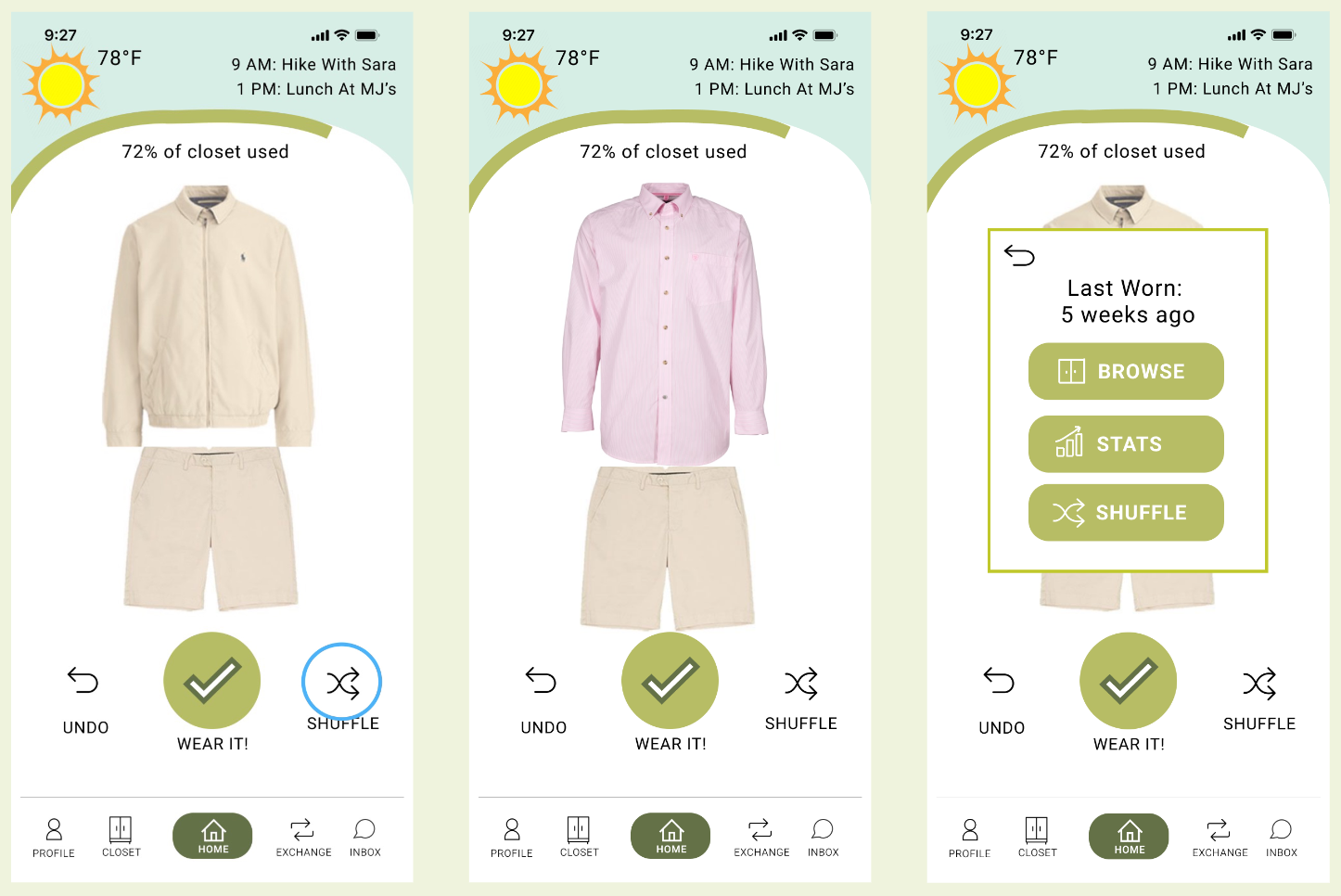
Homepage, clicking shuffle, and clicking on an item in the outfit
Clicking on Browse from the previous screen takes us to the closet, where the participant can replace any items in their outfit. They can also view their closet sorted by outfits/personal style or by statistics (most or least worn items/outfits).

Clothes tab: View full digitized closet. Outfits tab: View closet sorted by outfits and personal style. Stats tab: View clothes and outfits sorted by usage statistics.
Clicking on the Detailed Stats button gives us the leftmost page, from where the participant can view graphical representations of how often they've worn that item, outfit tags, options to add the item to their Give profile, or options to add it to their outfit for the day. Upon pressing Add to Outfit, the item is added to the outfit on the homepage.
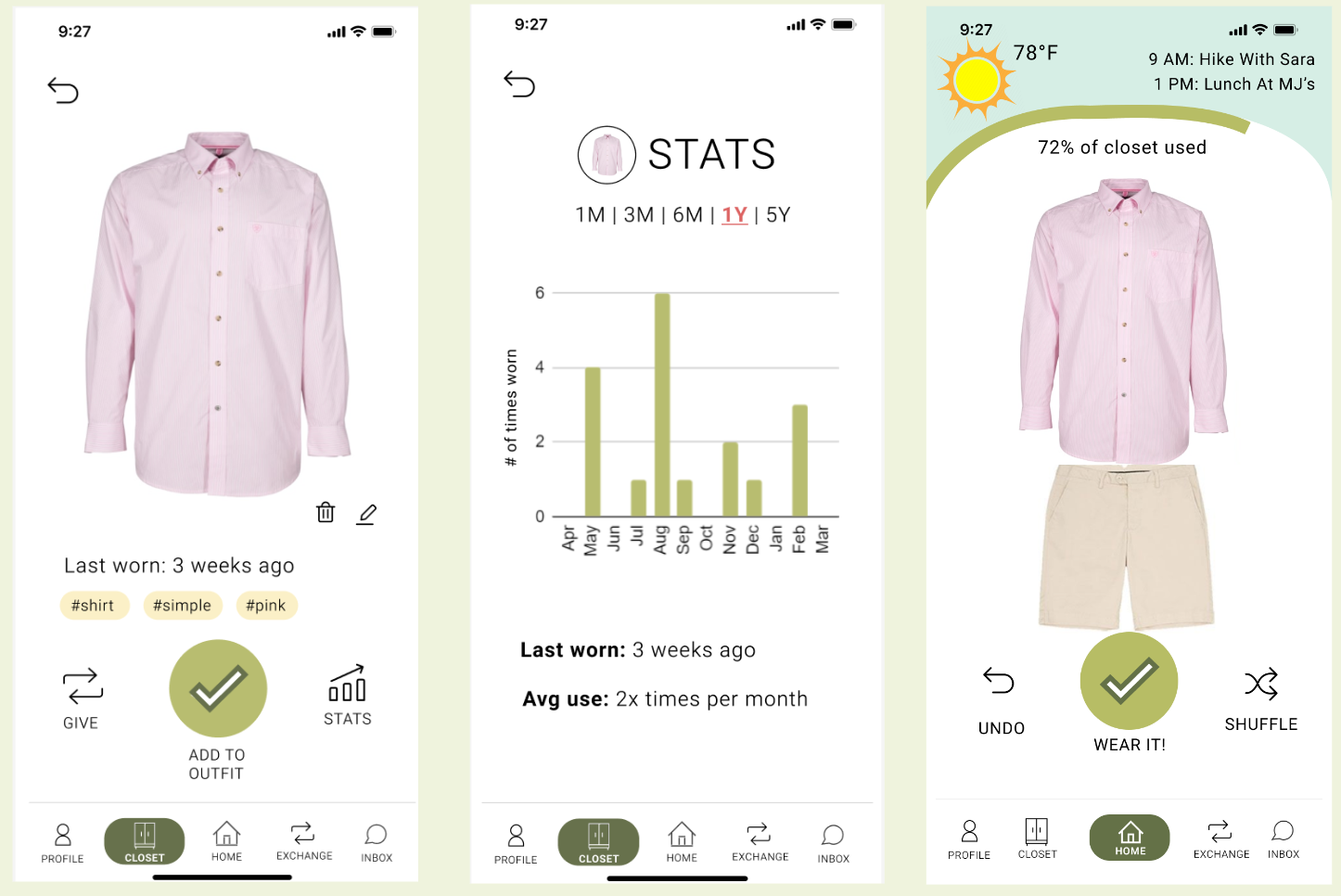
Detailed statistics for each item of clothing
When the participant clicks Wear It!, a pop-up confirms that they want to select the outfit on the homepage for the day, which helps the algorithm track clothing usage. When the participant confirms the outfit, their closet usage statistic updates to show them their sustainability progress.

Confirming the outfit of the day
Task 2: Facilitating the Exchange of Second-hand Clothing
The participant can navigate to the Exchange page, where they can view clothes they can get from other people or upload clothes to give (encouraging the reuse of clothing rather than throwing away).

Homepage and Exchange Get and Give pages
To give away an item, press the Plus button on the Give page and follow the prompts on the app to scan items using the scanner.

Adding an item to give away
After scanning the items, the participant can add more details to their post and then upload it to their Give page.

Creating a post
To coordinate exchanges, the participant can navigate to their Inbox and message others.
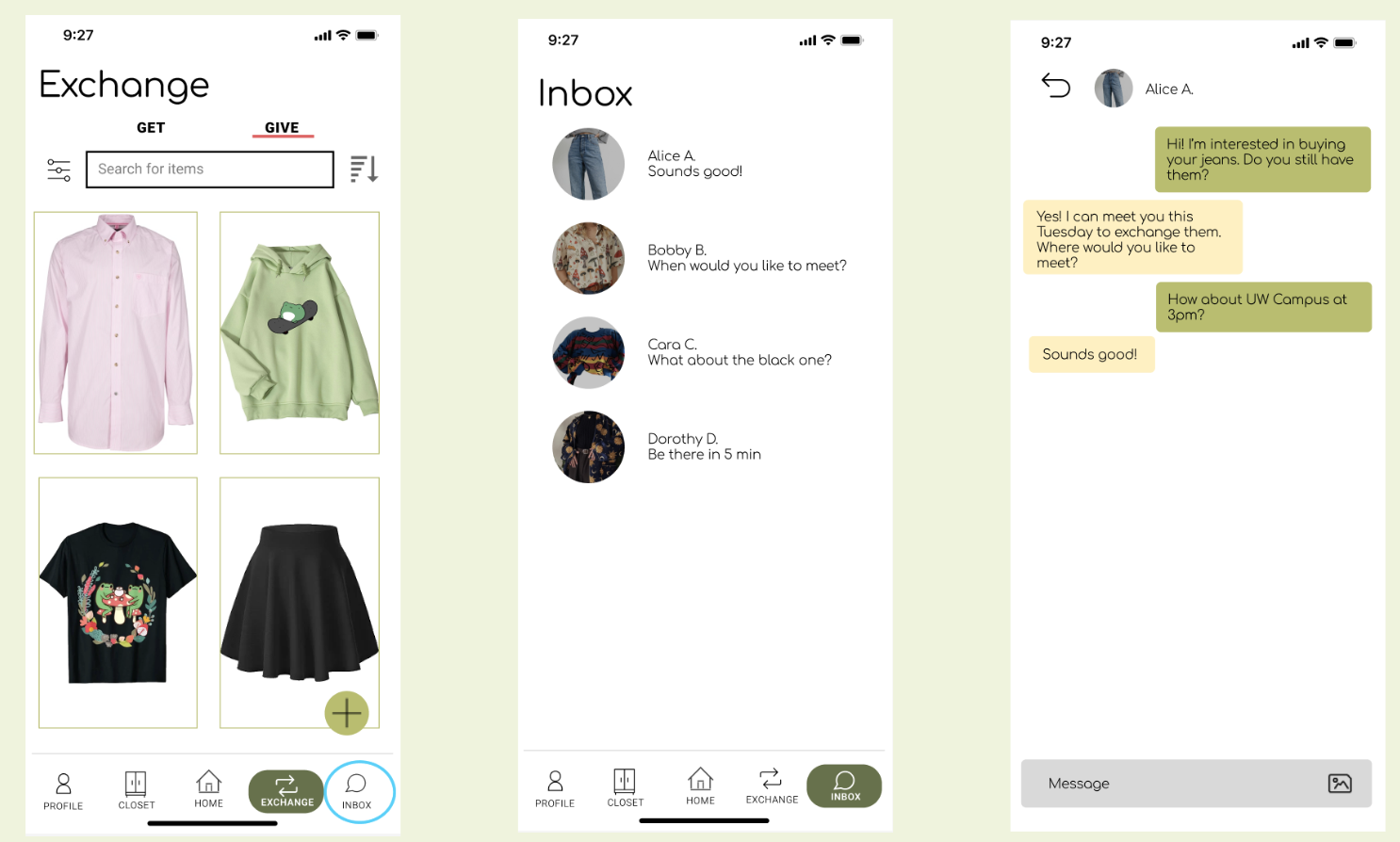
Coordinate exchanges